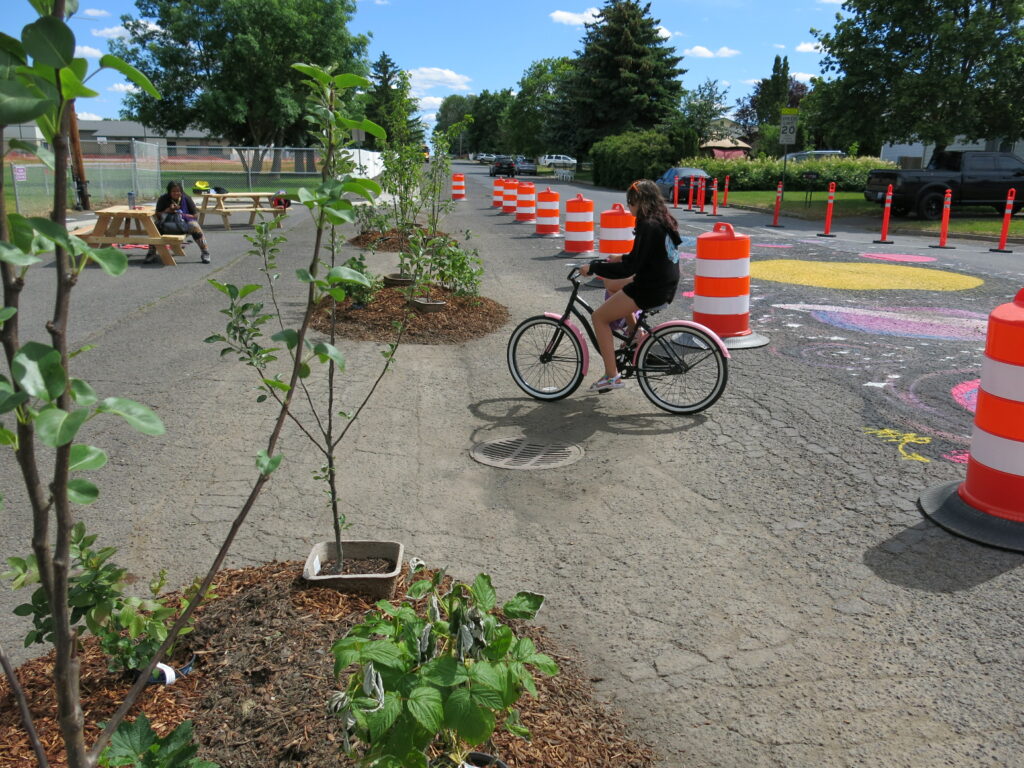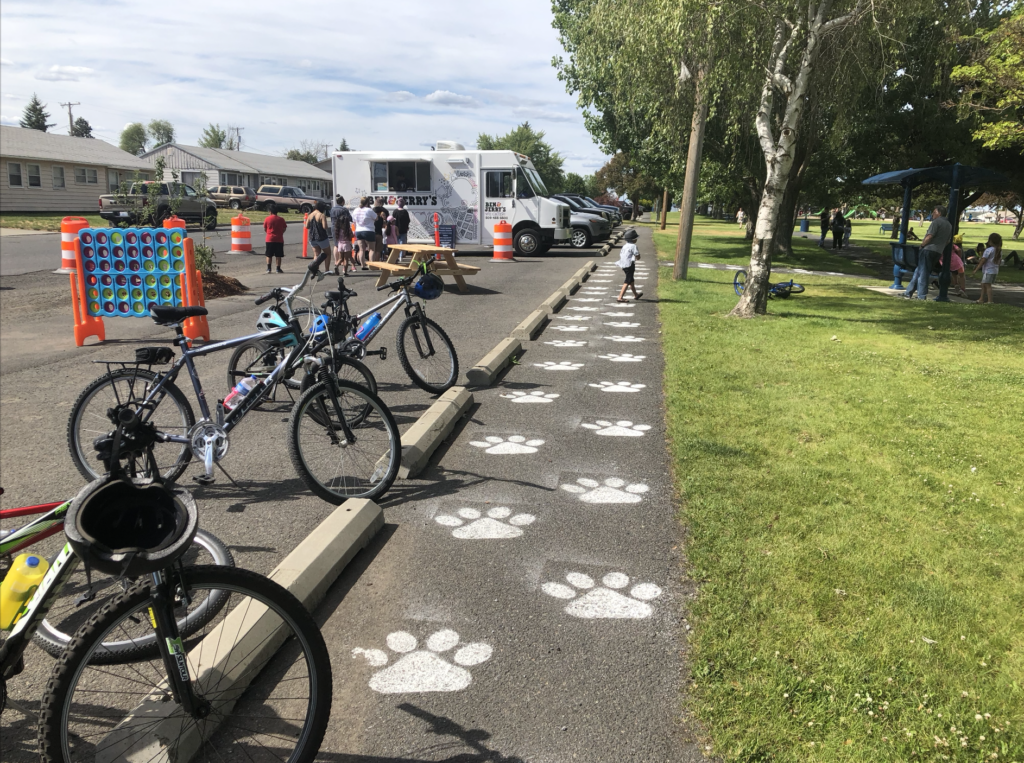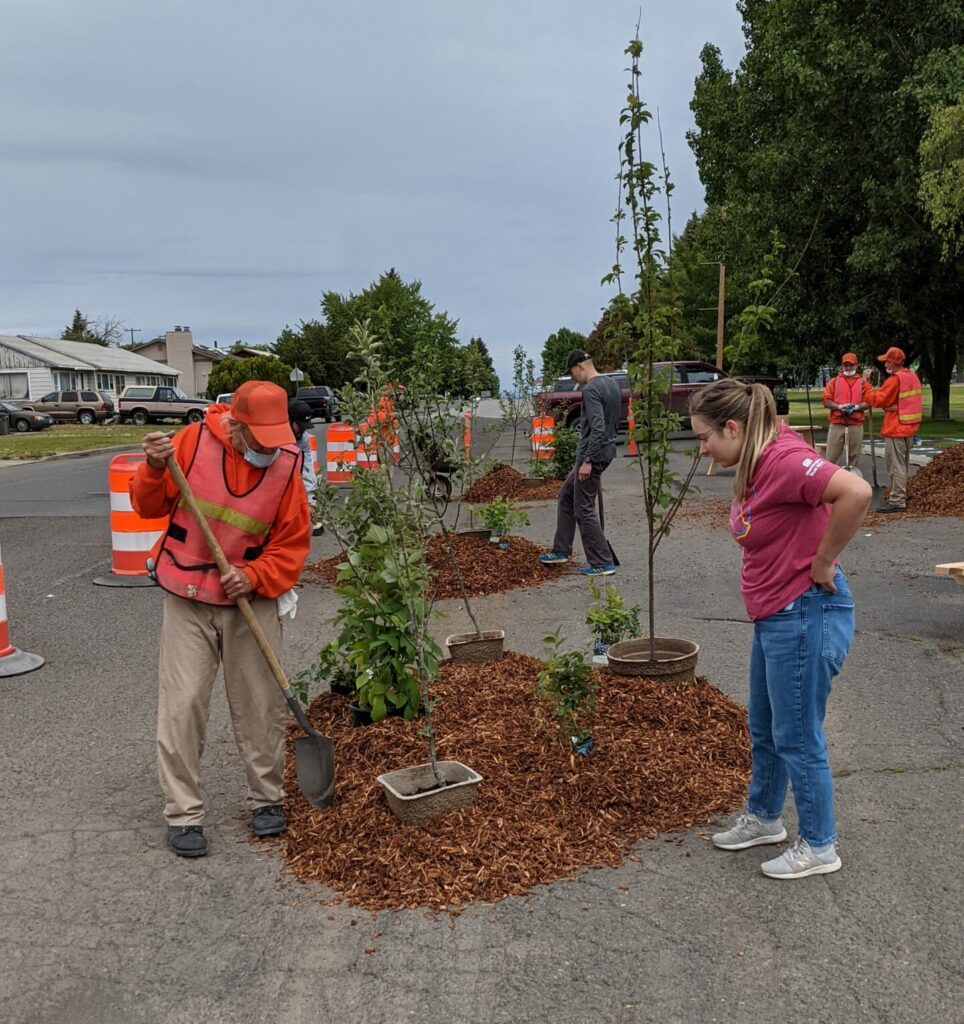Airway Heights, WA deployed their safety demonstration project on a key north-south connector in the city that abuts the town’s only school and a public park, generating excitement in the community and creating new safe spaces for people to gather during the pandemic.

Airway Heights, WA
King Street demonstration project
Budget: $8,693 / Demonstration length: One week
The city of Airway Heights, located just west of Spokane, is experiencing fast-paced growth. A lack of connectivity to goods and services has contributed to a pressing issue of food insecurity. King Street, running through a residential area near the heart of the city, provides key connections not just to stores on a major commercial corridor to the south but to Sunset Elementary (the only school within city limits) and Sunset Park. Unfortunately, the intersection adjacent to the park and school is a difficult place to walk, bike, roll, and even drive. Parking placement and uneven lanes force drivers to make awkward turns. Incomplete sidewalks and poorly placed crosswalks have led students to walk on the side of the road and even into a private resident’s lawn. By collaborating with multiple community partners, the Airway Heights team made valuable use of limited resources to create a traffic-slowing pavement mural, establish new crosswalks, fill in sidewalk gaps, and create a vibrant COVID-safe public gathering space. Their quick-build project successfully generated excitement and ownership from the surrounding community, increased walking and biking activity, and ultimately resulted in a safer route.
View the full package of profiles
With a population of about 10,030, Airway Heights is a small city experiencing fast-paced growth. (At the time of this project, the city’s population had increased over 63 percent in ten years.) Located just west of Spokane, the city derives its name from its proximity to the Fairchild Air Force Base. It is bounded by the base at one end and the Spokane International Airport on the other. The city includes both the Kalispel Tribe and Spokane Tribe land with housing, employment, and recreation opportunities. According to the 2019 American Community Survey, twenty-one percent of the population is low-income with limited resources, and one of the most pressing issues for the community is food insecurity.
To address these needs, the Airway Heights team chose the King Street and 10th Avenue intersection for their week-long project. King Street provides a connection to the major connecting highway, US-2, home to most of the city’s retail outlets and grocery stores. The intersection at 10th Avenue, located near the heart of the city, borders Sunset Park and Sunset Elementary, the only school within the city’s limits and a frequent destination for students walking and biking. King Street is also a key north-south route for connecting residents to the main residential area to the north and west of this site. By making King Street safer and more inviting, the team hoped to encourage more active transportation, bring the community together in a public space, and improve connectivity with the rest of the city.
Planning the project
Consisting of five people (including a traffic engineering consultant), the Airway Heights team was small but mighty, and their budget was limited. The team envisioned converting part of the intersection to temporary park space, but with no movable tables and benches to work with and limited traffic control equipment, the team quickly realized they would need to think outside of the box to make their project a success. They rented and borrowed equipment to guide traffic and pedestrians and enlisted the help of artists to help design the space and make it more inviting.
Understanding the risks presented by COVID, the team was careful to make their project a self-experience and not encourage mass gatherings. They provided large-scale games for multiple age groups, including life-size Jenga, tic-tac-toe, Connect Four, and frisbee. The team worked on a tight timeline to get the project up for the last week of school before summer break to ensure students and parents would be walking in the area and able to experience it.
The team used social media to invite people to see the project and talk about their experience at the site. When people visited the park, they would spot signage with a QR code for a survey, where they could share their reactions and feedback. Paired with a pre-project survey, this helped the team evaluate how the project influenced visitors’ perceptions of the intersection.
For one day, the team brought in a Ben & Jerry’s ice cream truck. The high volume of pedestrians attracted to the ice cream truck brought in valuable feedback, though the team removed walking count data for this day from their overall evaluation of the project so that they could get a more accurate sense of how people interacted with the space.

Before the project, staff members raised concerns about equipment theft and vandalism. For that reason, the team was careful to use as much heavy, non-mobile equipment for their demonstration as possible. But far more effective at eliminating the risk of damage was the community’s willingness to take ownership of the project. Without prompts from the Airway Heights team, multiple people who lived near the project said they would keep an eye on the area to make sure all materials were left alone. There wasn’t a single incident of theft or vandalism throughout the demonstration.
The team received a great deal of help from the community, so they decided to pay it all forward. They donated all materials they purchased for the project (including edible plants used as landscaping) to local programs and community members.
Slowing traffic and activating a neighborhood
King Street is wide, making it easier for drivers to speed through the largely residential area. The T-intersection at 10th Avenue includes parking and uneven lanes, creating awkward turning movements for drivers. Though this is a frequent site for kids walking to and from school, there is no continuous sidewalk, and crosswalks are sparse and poorly positioned. Before the project, one crosswalk to the school ended in a private citizen’s lawn. The team set out to create an inviting space, slow traffic, provide safer access to the school and park, and deliver a positive experience for the community along the way.
To help slow and ease the flow of traffic at the intersection, they enlisted the help of artists to create a mural with pavement-marking spray. The colorful artwork slowed cars and attracted pedestrians. They rented traffic control equipment and chalked pathways for students and pedestrians to get to school and travel around the park safely. To set up and take down their space, the team solicited help from the local correctional center work crew program. And to track the success of their project, they borrowed Miovision and Eco Cameras from Spokane County and the Washington State Department of Transportation, which documented the flow of pedestrians and traffic before and during the event.
To further improve health outcomes and slow traffic, the team incorporated edible landscaping like fruit trees and berry vines. These were an educational and functional resource that guided the flow of travel and raised awareness about the possibility to add new and diverse plant life to the park.

Over 100 families walked and biked into the demonstration project area in one day over the course of the week- long project. Many more enjoyed the project. The team doubled pedestrian and biker activity. Survey responses reflected the project’s effectiveness, including perceived reduced speeds while the demonstration was in place. As traffic slowed, local perception of the area shifted, and people began to see the area as a safe, convenient place for walking and biking. In addition, the community’s willingness to take ownership of the project spoke to its positive impact. As the team takes steps to turn their demonstration into a reality, they have already made one small, lasting change: the crosswalks they painted have been converted to permanent crossings.
Lessons learned
You can have a big impact with a small budget and small team.
With a few creative ideas and help from the surrounding community, the Airway Heights team put together a successful, engaging project without going over their modest budget of $8,693. Inexpensive resources like pavement paint and games activated their space. Renting and borrowing items, receiving help from volunteers and local partners, and discovering the unexpected resource of community buy-in all helped make this project into the success that it was.
Quick-build projects are a fun way to see how a project will work.
The Airway Heights team’s quick-build project allowed them to test their design in real time and gain valuable data to support their project’s efficacy. The bike and pedestrian usage statistics and survey responses will be key to arguing for permanent changes to the area. The project also created fun photo opportunities that help strengthen the team’s case for design change. Most importantly, the quick-build project was an engaging way to illustrate how a few changes could improve safety and convenience for the whole community.
Creating community ownership is vital.
The community of Airway Heights felt pride in having this sort of project in their city center. It helped them visualize what their growing community could be like in the future. In addition to providing positive feedback in their surveys, the community made their support of the project no secret when they voiced their willingness to protect it from vandalism and theft. This community ownership was a vital (and free!) resource the team relied on for the duration of their demonstration, and it spoke to the level of support the community had for the improvements the Airway Heights team had made. As the project lead, Heather Trautman said, “people really felt through this experience doing the demonstration project that Airway Heights was growing up as a town…[it] made everyone feel that they were really making progress on how we would be as a community in the future.”
—
These demonstration projects and case studies were supported in part by the Centers for Disease
Control and Prevention under cooperative agreement OT18-1802 supporting the Active People, Healthy NationSM Initiative. Active People, Healthy NationSM is a national initiative led by the CDC to help 27 million Americans become more physically active by 2027. Learn more.
Smart Growth America would also like to thank the Washington Transportation Improvement Board and Barr Foundation for their additional funding support for the demonstration projects in these case studies, as well as the Washington State Department of Health and Washington State Department of Transportation for their partnership throughout this program.